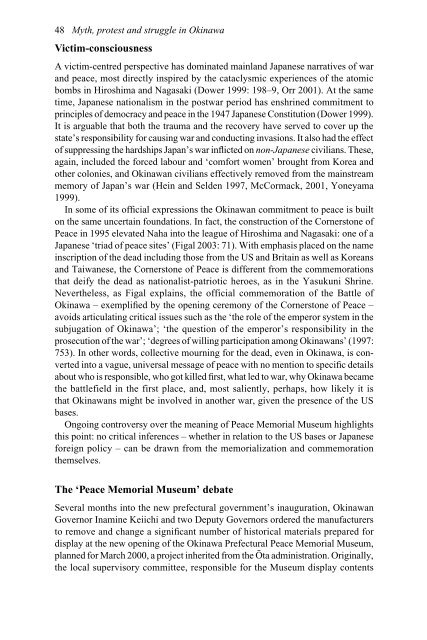Myth, Protest and Struggle in Okinawa
Myth, Protest and Struggle in Okinawa
Myth, Protest and Struggle in Okinawa
You also want an ePaper? Increase the reach of your titles
YUMPU automatically turns print PDFs into web optimized ePapers that Google loves.
48 <strong>Myth</strong>, protest <strong>and</strong> struggle <strong>in</strong> Ok<strong>in</strong>awa<br />
Victim-consciousness<br />
A victim-centred perspective has dom<strong>in</strong>ated ma<strong>in</strong>l<strong>and</strong> Japanese narratives of war<br />
<strong>and</strong> peace, most directly <strong>in</strong>spired by the cataclysmic experiences of the atomic<br />
bombs <strong>in</strong> Hiroshima <strong>and</strong> Nagasaki (Dower 1999: 198–9, Orr 2001). At the same<br />
time, Japanese nationalism <strong>in</strong> the postwar period has enshr<strong>in</strong>ed commitment to<br />
pr<strong>in</strong>ciples of democracy <strong>and</strong> peace <strong>in</strong> the 1947 Japanese Constitution (Dower 1999).<br />
It is arguable that both the trauma <strong>and</strong> the recovery have served to cover up the<br />
state’s responsibility for caus<strong>in</strong>g war <strong>and</strong> conduct<strong>in</strong>g <strong>in</strong>vasions. It also had the effect<br />
of suppress<strong>in</strong>g the hardships Japan’s war <strong>in</strong>flicted on non-Japanese civilians. These,<br />
aga<strong>in</strong>, <strong>in</strong>cluded the forced labour <strong>and</strong> ‘comfort women’ brought from Korea <strong>and</strong><br />
other colonies, <strong>and</strong> Ok<strong>in</strong>awan civilians effectively removed from the ma<strong>in</strong>stream<br />
memory of Japan’s war (He<strong>in</strong> <strong>and</strong> Selden 1997, McCormack, 2001, Yoneyama<br />
1999).<br />
In some of its official expressions the Ok<strong>in</strong>awan commitment to peace is built<br />
on the same uncerta<strong>in</strong> foundations. In fact, the construction of the Cornerstone of<br />
Peace <strong>in</strong> 1995 elevated Naha <strong>in</strong>to the league of Hiroshima <strong>and</strong> Nagasaki: one of a<br />
Japanese ‘triad of peace sites’ (Figal 2003: 71). With emphasis placed on the name<br />
<strong>in</strong>scription of the dead <strong>in</strong>clud<strong>in</strong>g those from the US <strong>and</strong> Brita<strong>in</strong> as well as Koreans<br />
<strong>and</strong> Taiwanese, the Cornerstone of Peace is different from the commemorations<br />
that deify the dead as nationalist-patriotic heroes, as <strong>in</strong> the Yasukuni Shr<strong>in</strong>e.<br />
Nevertheless, as Figal expla<strong>in</strong>s, the official commemoration of the Battle of<br />
Ok<strong>in</strong>awa – exemplified by the open<strong>in</strong>g ceremony of the Cornerstone of Peace –<br />
avoids articulat<strong>in</strong>g critical issues such as the ‘the role of the emperor system <strong>in</strong> the<br />
subjugation of Ok<strong>in</strong>awa’; ‘the question of the emperor’s responsibility <strong>in</strong> the<br />
prosecution of the war’; ‘degrees of will<strong>in</strong>g participation among Ok<strong>in</strong>awans’ (1997:<br />
753). In other words, collective mourn<strong>in</strong>g for the dead, even <strong>in</strong> Ok<strong>in</strong>awa, is converted<br />
<strong>in</strong>to a vague, universal message of peace with no mention to specific details<br />
about who is responsible, who got killed first, what led to war, why Ok<strong>in</strong>awa became<br />
the battlefield <strong>in</strong> the first place, <strong>and</strong>, most saliently, perhaps, how likely it is<br />
that Ok<strong>in</strong>awans might be <strong>in</strong>volved <strong>in</strong> another war, given the presence of the US<br />
bases.<br />
Ongo<strong>in</strong>g controversy over the mean<strong>in</strong>g of Peace Memorial Museum highlights<br />
this po<strong>in</strong>t: no critical <strong>in</strong>ferences – whether <strong>in</strong> relation to the US bases or Japanese<br />
foreign policy – can be drawn from the memorialization <strong>and</strong> commemoration<br />
themselves.<br />
The ‘Peace Memorial Museum’ debate<br />
Several months <strong>in</strong>to the new prefectural government’s <strong>in</strong>auguration, Ok<strong>in</strong>awan<br />
Governor Inam<strong>in</strong>e Keiichi <strong>and</strong> two Deputy Governors ordered the manufacturers<br />
to remove <strong>and</strong> change a significant number of historical materials prepared for<br />
display at the new open<strong>in</strong>g of the Ok<strong>in</strong>awa Prefectural Peace Memorial Museum,<br />
planned for March 2000, a project <strong>in</strong>herited from the Ōta adm<strong>in</strong>istration. Orig<strong>in</strong>ally,<br />
the local supervisory committee, responsible for the Museum display contents
















